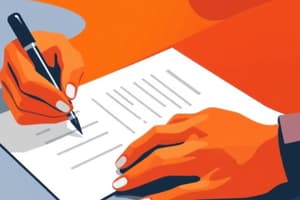Podcast
Questions and Answers
Match the following résumé headings with their descriptions:
Match the following résumé headings with their descriptions:
Personal details = Your name, address, and telephone numbers Skills = A summary of relevant abilities developed over past employment Education and training = List of academic qualifications in chronological order Referees = Names and contact details for individuals who can vouch for your work
Match the following elements with their correct purpose in a résumé:
Match the following elements with their correct purpose in a résumé:
Date the résumé prepared = Indicates the most current information provided Employment history = Chronological record of past job positions and responsibilities Responsibilities = Tasks performed in previous roles that demonstrate your capabilities Relevant volunteer work = Additional experiences that can highlight your skills
Match the type of reference with its description:
Match the type of reference with its description:
Previous employer = A reference from someone who has directly supervised you Colleague = A coworker who can discuss your teamwork abilities Mentor = An advisor who can vouch for your growth and development Client = Someone who has benefited from your services or skills
Match the following components of a résumé with their related checklist:
Match the following components of a résumé with their related checklist:
Match the following layout elements of a résumé with their importance:
Match the following layout elements of a résumé with their importance:
Flashcards are hidden until you start studying
Study Notes
Résumé Purpose and Importance
- A résumé, also known as a Curriculum Vitae (CV), aims to secure an interview with a potential employer.
- It serves as a concise advertisement showcasing skills and achievements.
- Employers infer assumptions about candidates based on their résumés, making professionalism crucial.
General Résumé Conventions
- The résumé's preparation date should be included to demonstrate the latest information.
- Personal details, including name, address, and phone numbers, are essential.
- Skills section should summarize relevant skills developed in past employment, supported by a portfolio.
- Education and training history should be listed in reverse chronological order, including:
- Dates of attendance (years only).
- Achieved level and training course name.
- Institution or training organization name.
- Employment history should be presented in reverse chronological order with start and end dates, including:
- Position held.
- Company name.
- Responsibilities.
- Prior experience can be mentioned under relevant skill headings.
- Focus only on relevant casual jobs, excluding short-term ones.
- Relevant volunteer work should be included.
- Referees:
- Provide full names, position titles, address, and contact details of two references.
- Include previous employers, character references, and school/lecturers (for recent graduates).
- Ensure references are current and positive about your skills.
Résumé Tips and Format
- Always keep clean and good quality photocopies of the document.
- Résumés should be typed.
- Ask someone to proofread for spelling and punctuation errors.
- Use bold headings and consistent fonts.
- Avoid fancy colours, fonts, borders, and personal details such as age, marital status, religion, nationality, or photographs.
- Limit the résumé to three pages.
- Employers prioritize the first page, reading progressively less of subsequent pages.
- Prepare the résumé as a Word document or a PDF for easy emailing and online applications.
Studying That Suits You
Use AI to generate personalized quizzes and flashcards to suit your learning preferences.




